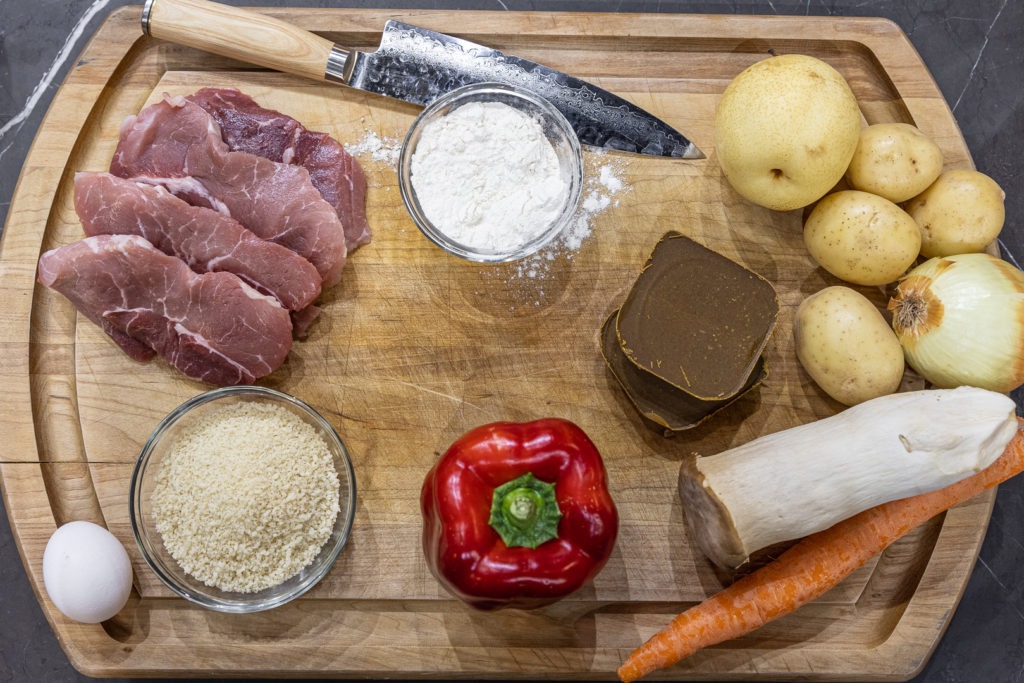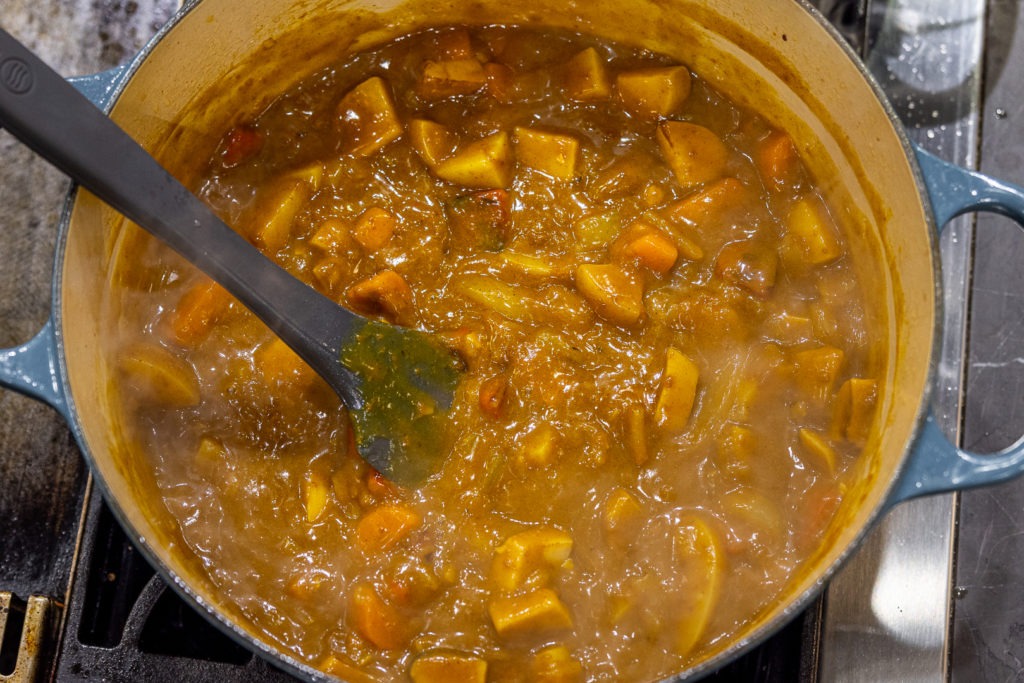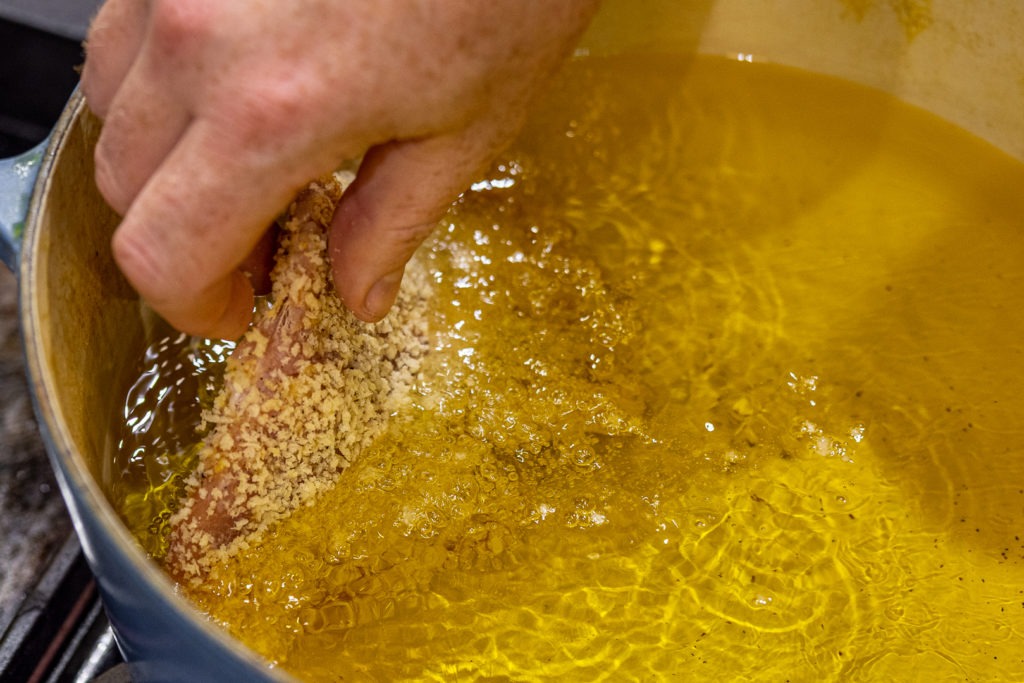Description
Pork Katsu with Japanese Curry, with guidance from Just One Cookbook.
Ingredients
Scale
For the curry:
- 2 Tbsp neutral oil
- 1 tsp sesame oil (optional)
- 1 onion, sliced
- 1 red bell pepper, diced
- 1 carrot, peeled and sliced
- 1 large king oyster mushroom, cut into chunks (usually available at Asian markets—4 oz other mushrooms if you can’t find them)
- 1 apple or Asian pear, grated or finely diced
- ~10 oz potatoes, cut into chunks
- 6 cups water
- 7.8 oz package of curry cubes Golden Curry or Vermont Curry brands are good)
For the katsu:
- 1 C panko bread crumbs
- 4 boneless pork chops
- Salt and pepper
- 1/2 C flour
- 2 eggs
- 1 Tbsp oil
Also, white rice and pickled vegetables for serving
Instructions
Make the curry
- Heat the neutral oil in a large heavy pot over medium-high heat until nearly smoking. Add the sesame oil.
- Add the onions and peppers, sauté until blistered and a little charred on the edges.
- Added the carrot slices, sauté until browning.
- Add the mushroom chunks, same story.
- Add the pear/apple and cook a couple more minutes.
- Add the potatoes and water. Bring to a boil and turn down to a simmer.
- When the potatoes have cooked through, add the curry roux to the pot and continue to cook, stirring, until the cubes have melted completely and the curry is thickened.
- Adjust the consistency by cooking longer to thicken or by adding water if too thick. Taste and adjust the salt.
- Set the curry aside with a lid on it to keep it warm.
Prepare the katsu
- Place your panko in a wide dish and spritz it thoroughly with water. Let the panko soak up the water as you prepare everything else. It should be somewhat soft as if you had made breadcrumbs from fresh bread.
- Start preheating 2–3 inches of neutral oil in a pot suitable for deep frying. Use your ChefAlarm and set the high-temp alarm for 340°F (171°C).
- Pound the pork chops out between two sheets of plastic using a meat mallet. A torn-open freezer bag works wonderfully for this. The cutlets should be about 1/4″ thick.
- Season the cutlets with salt and black pepper
- Whisk the eggs together with the tablespoon of oil.
- Bread the cutlets by first dredging them in flour, then dipping them in the beaten eggs, then coating them in the softened panko.
- Set the breaded cutlets aside until the oil is hot.
- When the ChefAlarm sounds, add one cutlet to the oil (two, if your pot will allow it without them interfering with each other).
- Cook the cutlet for 1 minute, turning it over with tongs halfway through.
- Remove the cutlet from the oil and set it aside to drain while you cook the other ones.
- Allow the oil to return to 340°F (171°C) before cooking the next cutlet.
- When all of the pork pieces have been fried once, change the high-temp alarm on your ChefAlarm to 355° ( 179°C) and heat the oil to that point.
- Re-fry each piece of pork for another minute. If you are concerned your cutlets are too thick and might not be done inside, verify the internal temp with your Thermapen ONE. Allow them to drain on a rack set in a cookie sheet or on some paper towels.
Put it all together
- Cut each katsu into strips across its short axis. Lay those strips on a bed of white rice on your plate
- Ladle a healthy portion of curry onto the katsu.
- Garnish with pickled daikon and serve it up!
Notes
This recipe for curry makes more than you’ll “need” for the katsu. Serve any leftovers warmed up on more rice. Or maybe just go heavy on the sauce and don’t have any leftovers? Either way.
If you want to do this with chicken instead of pork, the process is exactly the same, but do check those internal temps to make sure they are over 165°F (74°C). You won’t have a lot of thermal mass or time-at-temp to kill the bacteria slowly.



